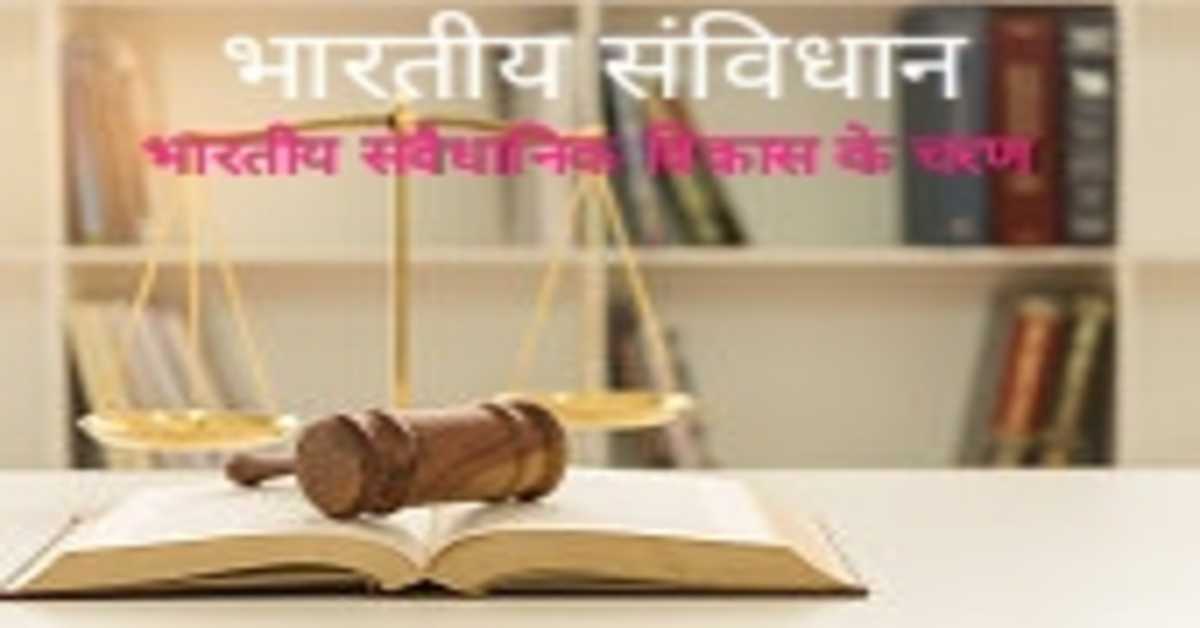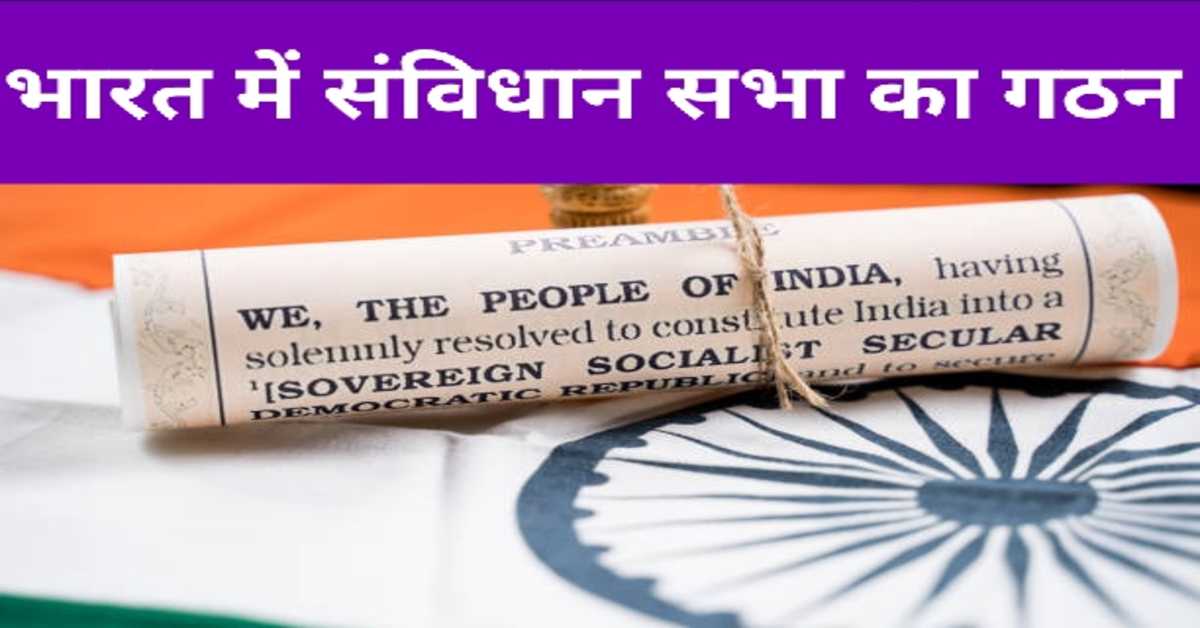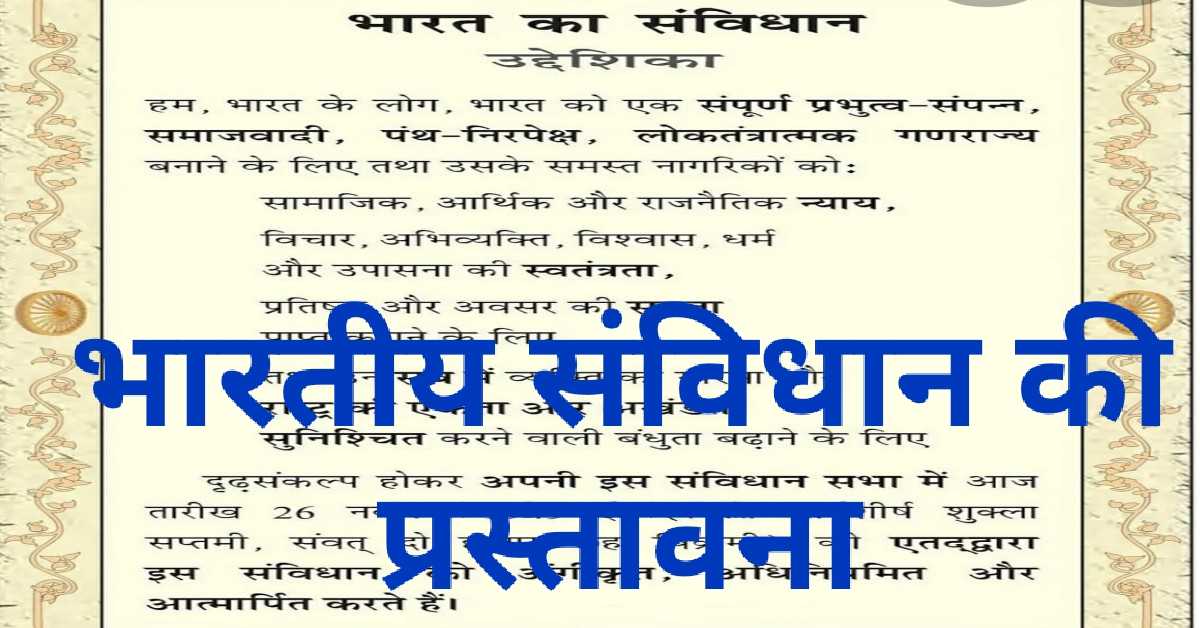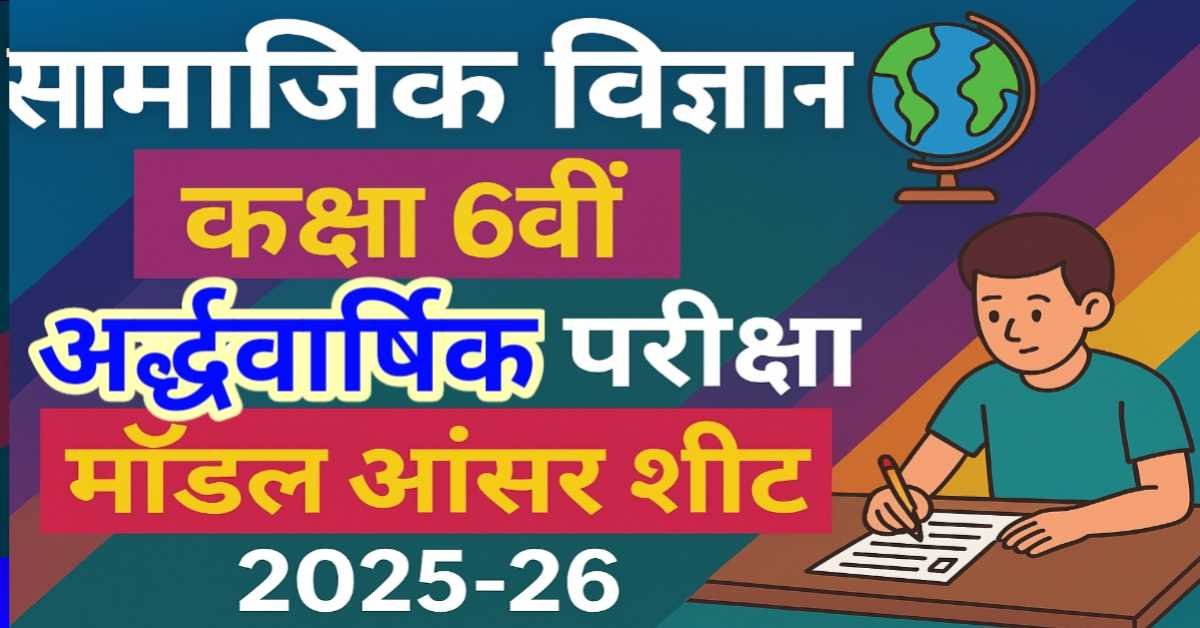
भारतीय संवैधानिक विकास के चरण | Stages of Indian Constitutional Development
संविधान एक लिखित दस्तावेज होता है, जिसमें शासन व्यवस्था से संबंधित विभिन्न नियम तथा उपनियम होते हैं। संविधान के अनुसार ही सरकार का संचालन किया जाता है। संविधान के अनुसार देश की राजनीतिक व्यवस्था का बुनियादी ढांचा निर्धारित किया जाता है। किसी भी देश का संविधान वहाँ की विधायिका, कार्यपालिका तथा न्यायपालिका के द्वारा शासन के संचालन को निर्धारित करता है। यह उनकी स्थापना, शक्तियों तथा दायित्व का सीमांकन करता है। संविधान जनता और राज्य के बीच संबंधों का विनियमन करता है। संविधान के माध्यम से देश के आदर्शों, उद्देश्यों तथा मूल्यों के विषय में जानकारी प्राप्त होती है। संविधान में निरंतरता होती है। यह एक जड़ दस्तावेज नहीं है। देश में वर्षों से चली आ रही परंपराएँ भी देश के शासन तथा संविधान में महत्वपूर्ण भूमिका निभाती हैं। देश की सर्वोच्च विधि संवैधानिक विधि है। इसी के द्वारा देश की अन्य विधियाँ निर्धारित होती हैं।
Constitution is a written document, which contains various rules and bye-laws related to governance. The government is run according to the constitution. The basic structure of the political system of the country is determined according to the constitution. The constitution of any country determines the conduct of governance by legislative, executive and judiciary there. It demarcates their establishment, powers and responsibilities. The constitution regulates the relationship between the people and the state. Information about the ideals, objectives and values of the country is obtained through the constitution. There is continuity in the constitution. This is not a root document. The traditions going on in the country for years also play an important role in the governance and constitution of the country. The supreme law of the country is constitutional law. Other laws of the country are determined by this.
इस 👇 बारे में भी जानें।
1. भारतीय संविधान के स्रोत
2. भारतीय संविधान का निर्माण
संविधान कानून निर्माण करने वाले व्यक्ति को निर्धारित करता है। यह देश में शक्ति के मूल वितरण को निर्धारित करता है। संविधान के अनुसार सरकार का निर्माण तथा निर्धारण किया जाता है। संविधान यह सुनिश्चित करता है कि समाज में निर्णय लेने की शक्ति किसके पास होगी। संविधान के द्वारा समाज को बुनियादी ढाँचा प्राप्त होता है। यह समाज की आकांक्षा तथा लक्ष्यों की अभिव्यक्ति करता है। यह उचित परिस्थितियों में न्यायपूर्ण समाज की स्थापना करता है। संविधान के अंतर्गत राजव्यवस्था के प्रमुख अंगों की स्थापना की जाती है। शासन के प्रमुख अंग कार्यपालिका, विधायिका तथा न्यायपालिका है। संविधान इनकी शक्तियों, दायित्व तथा अधिकारों को निर्धारित करता है। संविधान के द्वारा राज्य के अंगों के अधिकार को निरंकुश तथा तानाशाह होने से रोका जा सकता है। संविधान एक दर्पण के समान है, इससे देश के वर्तमान, भूत और भविष्य की झलक प्राप्त होती है।
The constitution determines the person who makes the law. It determines the basic distribution of power in the country. The government is formed and determined according to the constitution. The constitution ensures who will have the decision-making power in the society. The society gets the basic structure through the constitution. It expresses the aspirations and goals of the society. It establishes a just society under proper conditions. The main organs of the polity are established under the constitution. The main organs of government are the executive, legislature and judiciary. The constitution prescribes their powers, responsibilities and rights. By the constitution, the authority of the organs of the state can be prevented from being autocratic and dictatorial. Constitution is like a mirror, it gives a glimpse of the present, past and future of the country.
भारत के संविधान तथा राजव्यवस्था के अनेक उपादान ब्रिटिश शासन से लिए गए हैं। भारत पर ब्रिटिश शासन के समय विभिन्न अधिनियम बनाए गए थे। इन्हीं के माध्यम से देश पर शासन किया जाता था। इन्हीं नियमों तथा उपनियमों के द्वारा भारतीय सरकार तथा प्रशासन के विधिक रूपरेखा को निर्धारित किया गया है। भारत में संवैधानिक विकास के प्रमुख चरण निम्नलिखित हैं-
Many components of the constitution and polity of India have been taken from the British rule. Various Acts were made during the time of British rule over India. Through them the country was ruled. Through these rules and bye-laws, the legal framework of the Indian government and administration has been determined. Following are the major stages of constitutional development in India-
रेग्युलेटिंग एक्ट (1773)- इस अधिनियम को भारत में ब्रिटिश शासन के समय लाया गया था। इसके अंतर्गत देश में पहली बार कंपनी के शासन के लिए लिखित संविधान दिया गया था। भारत के संवैधानिक इतिहास में इसका महत्वपूर्ण स्थान है। इसी अधिनियम के द्वारा देश में संसदीय नियंत्रण प्रारंभ हुआ। इसके द्वारा तत्कालीन समय में मुंबई तथा मद्रास प्रेसीडेंसी को कलकत्ता प्रेसीडेंसी के अधीन कर लिया गया था। इसके अंतर्गत कलकत्ता प्रेसिडेंसी में सरकार की स्थापना की गई थी, जिस पर गवर्नर जनरल तथा 4 सदस्यों वाले परिषद् का नियंत्रण था। सन् 1774 में कलकत्ता में सुप्रीम कोर्ट स्थापित की गई थी। इसके मुख्य न्यायाधीश 'सर एलिजाह इम्पे' थे। इस सुप्रीम कोर्ट के अंतर्गत बंगाल, बिहार और उड़ीसा सम्मिलित थे। कोलकाता प्रेसिडेंसी के गवर्नर जनरल और उनके परिषद को भारत के सचिव की पूर्व अनुमति पर कानून बनाने का अधिकार दिया गया। परिणाम स्वरूप बंगाल का गवर्नर भारत की तीनों प्रेसिडेंसीयों का 'गवर्नर जनरल' बन गया। इसके अंतर्गत बंगाल का पहला गवर्नर जनरल 'लॉर्ड वारेन हेस्टिंग्स' बना। इन सब के अतिरिक्त इस अधिनियम के द्वारा कंपनी के कर्मचारियों को निजी व्यापार तथा भारतीय लोगों से रिश्वत लेने पर प्रतिबंध लगा दिया गया। कंपनी पर गवर्निंग बॉडी अर्थात् ब्रिटिश कोर्ट ऑफ डायरेक्टर्स का नियंत्रण बढ़ गया। इसके द्वारा देश के राजस्व, नागरिक तथा सैन्य मामलों की महत्वपूर्ण जानकारी ब्रिटिश सरकार को देना अनिवार्य हो गया तथा व्यापार की समस्त सूचनाएँ क्राउन को दी जाने लगीं।
Regulating Act (1773)- This act was brought during the British rule in India. Under this written constitution was given for the first time in the country for the governance of the company. It has an important place in the constitutional history of India. Parliamentary control started in the country through this act. By this the Bombay and Madras Presidencies were brought under the Calcutta Presidency at that time. Under this, the government was established in the Presidency of Calcutta, which was controlled by the Governor General and the Council of 4 members. The Supreme Court was established in Calcutta in 1774. Its Chief Justice was 'Sir Elijah Impey'. Bengal, Bihar and Orissa were included under this Supreme Court. The Governor General of Kolkata Presidency and his Council were empowered to make laws with the prior permission of the Secretary to India. As a result, the Governor of Bengal became the 'Governor General' of the three Presidencies of India. Under this, the first Governor General of Bengal became 'Lord Warren Hastings'. In addition to all this, the Act prohibited the employees of the company from doing private business and taking bribes from Indian people. The Governing Body i.e. British Court of Directors increased control over the company. By this it became mandatory to give important information about the country's revenue, civil and military affairs to the British Government and all the information of trade was given to Crown.
पृथ्वी की संरचना एवं इस पर होने वाली हलचलों से संबंधित इन 👇 प्रकरणों के बारे में भी जानें।
1. पृथ्वी की संरचना
2. पृथ्वी की गतियाँ
3. अक्षांश एवं देशांतर रेखाएँ
4. भूकंप एवं भूकम्पीय तरंगे
5. सुनामी और ज्वालामुखी क्या है
6. पृथ्वी पर ज्वार भाटा
7. ग्रहण, ऋतु परिवर्तन विषुव एवं सुपरमून
एक्ट आफ सेटेलमेंट (1781)- रेगुलेटिंग एक्ट में कुछ कमियाँ थीं। इन कमियों को दूर करने हेतु 'एक्ट आफ सेटेलमेंट' लाया गया था। इसके अंतर्गत कलकत्ता की सरकार को बंगाल, बिहार तथा उड़ीसा के लिए भी विधि निर्माण की शक्ति दी गई। इसके अंतर्गत सर्वोच्च न्यायालय के द्वारा कंपनी के कर्मचारियों पर कार्रवाई करने पर प्रतिबंध लगा दिया गया। इसमें ऐसे कर्मचारी शामिल थे, जो सरकारी अधिकारी थे। परिणाम स्वरूप कंपनी के अधिकारी शासन के लिए किए गए कार्यों के लिए सर्वोच्च न्यायालय के कार्य क्षेत्र से बाहर हो गए। ब्रिटिश सरकार के इस अधिनियम का मुख्य उद्देश्य गवर्नर जनरल की परिषद और सर्वोच्च न्यायालय के मध्य संबंधों के सीमांकन को निर्धारित करना था। इस अधिनियम के द्वारा ब्रिटिश सरकार ने न्यायालय को कानून बनाने एवं उनके क्रियान्वयन करते समय भारत के सामाजिक और धार्मिक रीति-रिवाजों का सम्मान करने का निर्देश दिया।
Act of Settlement (1781)- There were some shortcomings in the Regulating Act. 'Act of Settlement' was introduced to remove these shortcomings. Under this, the Government of Calcutta was given the power to make laws for Bengal, Bihar and Orissa also. Under this, the Supreme Court banned the company's employees from taking action. This included employees who were government officials. As a result the officers of the Company were left out of the purview of the Supreme Court for the work done for the governance. The main purpose of this act of the British Government was to determine the demarcation of relations between the Governor-General's Council and the Supreme Court. Through this act, the British government directed the court to respect the social and religious customs of India while making laws and implementing them.
पिट्स इंडिया एक्ट (1784)- इस अधिनियम को सन् 1784 में ब्रिटिश संसद में भारत के तत्कालीन प्रधानमंत्री विलियम पिट ने प्रस्तुत किया था। इस अधिनियम के द्वारा निदेशक मंडल अर्थात् कोर्ट ऑफ डायरेक्टर्स को कंपनी के व्यापारिक मामलों के अधीक्षण की अनुमति प्रदान की गई। इसके अतिरिक्त देश के राजनीतिक मामलों के प्रबंधन के लिए नियंत्रण बोर्ड अर्थात् बोर्ड ऑफ कंट्रोल का गठन किया गया। परिणाम स्वरूप देश में द्वैध शासन व्यवस्था प्रारंभ हुई। भारत के संवैधानिक इतिहास में यह अधिनियम महत्वपूर्ण है। इसके द्वारा भारत में कंपनी के अधीन क्षेत्रों को सर्वप्रथम ब्रिटिश आधिपत्य क्षेत्र कहा गया। ब्रिटिश सरकार को देश में कंपनी और प्रशासन से संबंधित महत्वपूर्ण कार्यों पर पूर्ण नियंत्रण दिया गया। तीनों प्रेसिडेंसीयों के गवर्नर जनरल की सदस्य संख्या को 4 से घटाकर 3 कर दी गयी। मद्रास और मुंबई की सरकारों को पूर्ण रूप से बंगाल सरकार के अधीन कर दिया गया।
Pitt's India Act (1784)- This Act was introduced in the British Parliament in 1784 by the then Prime Minister of India William Pitt. The Act allowed the Board of Directors i.e. Court of Directors to superintend the business affairs of the company. Apart from this, Board of Control i.e. Board of Control was formed to manage the political affairs of the country. As a result Dual government system started in the country. This act is important in the constitutional history of India. By this the territories under the Company in India were first called British Occupation Area. The British government was given complete control over important functions related to the company and administration in the country. The number of Governor Generals of the three presidencies was reduced from 4 to 3. The governments of Madras and Mumbai were completely subordinated to the Government of Bengal.
इन 👇एतिहासिक महत्वपूर्ण प्रकरणों को भी पढ़ें।
1. विश्व की प्रथम चार सभ्यताएँ- मेसोपोटामिया, मिस्र, सिंधु, और चीनी सभ्यता
2. भारत का इतिहास- प्राचीन भारतीय इतिहास के अध्ययन के पुरातात्विक स्रोत।
3. भारत का इतिहास- प्राचीन भारतीय इतिहास जानने के साहित्यिक स्त्रोत- वेद
4. भारत का इतिहास- सिंधु सभ्यता के प्रमुख स्थल
5. सिन्धु सभ्यता में जीवन
आशा है, यह जानकारी परीक्षार्थियों हेतु प्रतियोगिता परीक्षाओं की तैयारी के लिए महत्वपूर्ण और उपयोगी होगी।
धन्यवाद।
RF Temre
infosrf.com
संबंधित जानकारी नीचे देखें।
(Watch related information below) 👇🏻

आशा है, उपरोक्त जानकारी उपयोगी एवं महत्वपूर्ण होगी।
(I hope the above information will be useful and important. )
Thank you.
लेखक
(Writer)
infosrf.com








